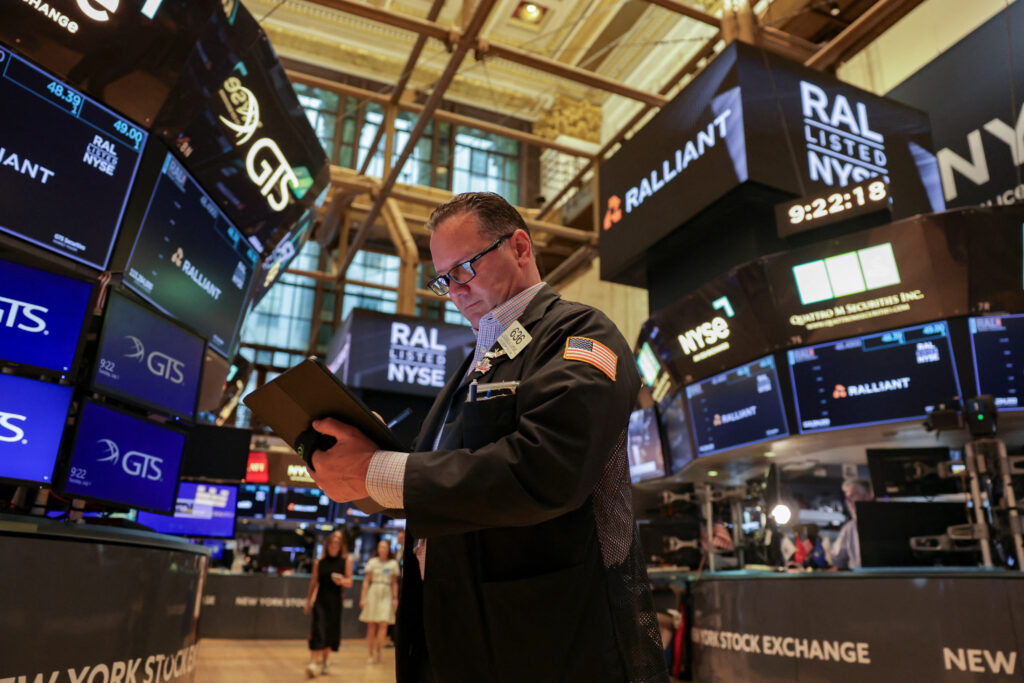

(Reuters)
Wall Street’s major indexes slipped on Monday as heightened tariff tensions dampened risk sentiment, while Tesla shares slid after CEO Elon Musk announced plans to launch a political party.
Treasury Secretary Scott Bessent said the U.S. will make several trade announcements in the next 48 hours, ahead of a deadline on Wednesday to finalise trade pacts.
President Donald Trump said on Sunday that the country was closer to inking several trade pacts and would notify other countries of higher tariff rates by July 9. He added that those duties are set to take effect on August 1.
In April, Trump unveiled a base tariff rate of 10% on most countries and additional duties ranging up to 50%, subsequently pushing the Nasdaq into a bear market.
Although he later delayed the effective date for all but 10% until July 9. The new date offers countries a three-week window for further negotiations.
Trump also threatened an extra 10% tariff on countries aligning themselves with the “Anti-American policies” of the BRICS group of Brazil, Russia, India, China and South Africa.
At 10:22 a.m. ET, the Dow Jones Industrial Average fell 207.65 points, or 0.46%, to 44,620.88, the S&P 500 lost 27.38 points, or 0.44%, to 6,251.97 and the Nasdaq Composite lost 115.56 points, or 0.56%, to 20,485.13.
Nine of eleven major S&P sectors were trading in the red, with consumer discretionary falling the most by 1%.
Electric vehicle maker Tesla dropped 6.8% – on track for its worst day in over a month – after Musk announced the formation of a U.S. political party named the “American Party”, marking a new escalation in his feud with Trump.
“Tesla investors are starting to vote their displeasure with him getting back into politics. The potential for him to start his own American party is just the exact opposite of what Tesla investors want,” said Art Hogan, chief market strategist at B Riley Wealth.
Shares of WNS jumped 14.2% after the French IT services firm Capgemini agreed to buy the outsourcing firm for $3.3 billion in cash.
Monday’s pullback also comes after the S&P 500 and the Nasdaq closed at record highs on Thursday following a surprisingly strong jobs report that pointed to resilience in the labor market.
The Dow was about 1% away from an all-time high.
Solid jobs data also backed the Federal Reserve’s cautious stance on future interest rate cuts.
Traders have fully priced out a July rate cut, with September odds at 64.4%, according to CME Group’s FedWatch tool.
Trump’s inflation-causing tariff policies have further complicated the Fed’s path to lower rates. As a result, minutes of its June meeting, scheduled for release on Wednesday, should offer more clues on the monetary policy outlook.
Attention is also on a sweeping tax-cut and spending bill, passed by House Republicans after markets closed on Thursday, that is set to swell the national deficit by over $3 trillion in the next decade.
Declining issues outnumbered advancers by a 2.1-to-1 ratio on the NYSE, and by a 1.86-to-1 ratio on the Nasdaq.
The S&P 500 posted 21 new 52-week highs and three new lows, while the Nasdaq Composite recorded 69 new highs and 32 new lows.







Comments